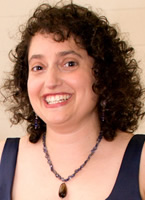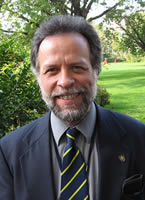|
| |
|

|
|

|
|
Dr. Sarah Greenwald
|
|
Dr. Robert E. Bradley
|
|
Dr. Sarah Greenwald
|
|
|
Appalachian State University
|
|
|
Biography:
|
Sarah J. Greenwald is a Professor of Mathematics and a Women's Studies core faculty member at Appalachian State University. She received her PhD from the University of Pennsylvania. Her scholarship areas include Riemannian geometry, popular culture as it pertains to mathematics, and women and minorities in mathematics, and she is a 2005 Mathematical Association of America Alder Award winner for distinguished teaching. She is a member of the executive committee of the Association for Women in Mathematics and the editorial board of PRIMUS. She co-created the educational website SimpsonsMath.com with Andrew Nestler. While it is not affiliated with the show, the site was mentioned in the audio commentary of the 7th season of The Simpsons. Her interactive mathematics lecture has been distributed on approximately one million DVDs worldwide as a 25-minute DVD extra for the 20th Century Fox Futurama movie Bender's Big Score and it is listed as "Mind-bending." Dr. Greenwald has spoken about the impacts of scientific popular culture representations on NPR's Science Friday and all over the country.
|
|
|
Title:
|
Good News Everyone! Mathematical Morsels from The Simpsons and Futurama
|
|
|
Abstract:
|
Did you know that The Simpsons and Futurama contain hundreds of humorous
mathematical and scientific references? What curious mathematical object is used
as a bottle for beer in the 31st century? What happens when Homer tries to
emulate Thomas Edison? What is the significance of the number 1729?
The only prerequisite for this talk is an open mind, so come find out! We'll
explore the mathematical content of some favorite moments along with the
motivations and backgrounds of the writers during an interactive talk. In the
process we'll look at related, recent work in geometry and computational number
theory so a calculator and writing utensil will be useful. For more information,
check out SimpsonsMath.com and FuturamaMath.com.
|
|
|
Title:
|
Rubik's Cube Games on Spheres: Geometry of Spherical Orbifolds
|
|
|
Abstract:
|
We'll slice up basketballs in order to form new spaces like footballs and triangular pillows, and then look at the geometry of the resulting spaces, called orbifolds. Orbifolds furnish a natural starting point for the study of singular spaces and they are especially of interest to mathematicians and physicists. Diverse applications of orbifolds include connections to crystallography, string theory and music theory. Many results, such as those requiring local analysis, generalize easily to the orbifold setting, but most global results do not. Imagine a spherical Rubik's game where you can rotate spherical triangles on the surface of the sphere. This game exists and is called the Impossiball and we'll use it to help understand orbifolds, as we look at lots of examples and results related to the diameter, Euler characteristic, and spectrum.
|
»
BACK TO TOP
|
Dr. Robert E. Bradley
|
|
|
Adelphi University
|
|
|
Biography:
|
Rob Bradley is Professor of Mathematics at Adelphi University, near New York City. He is a graduate of Concordia University in Montreal and he studied mathematics and philosophy as a Rhodes Scholar at Oxford University. His Ph.D. is from the University of Toronto, where he was a student of Mustafa Akcoglu. His interests include probability and ergodic theory, but his recent research has been in the history of mathematics, especially the history of analysis. He is President of the Euler Society and President-Elect of the History of Mathematics Special Interest Group of the Mathematical Association of America. With Ed Sandifer, he wrote Cauchy's Cours d'analyse: An Annotated Translation (Springer 2009) and edited Leonhard Euler: Life, Work and Legacy (Elsevier 2007). With Ed Sandifer and Larry D'Antonio he edited Euler at 300: An Appreciation (MAA 2007). He is currently working on an annotated translation of the first-ever calculus book: l'Hopital's 1696 text Analyse des infiniment petits. He performs both classical and folk music and is the bassist for The Wickers Creek Band, an Upstate New York bluegrass quintet.
|
|
|
Title:
|
From Differentials to Limits: Fleeting Flirtations and Lingering Loyalties
|
|
|
Abstract:
|
In its original form, the calculus dealt with the geometry of infinitely small quantities, or differentials, related to one another by equations. It was powerful and useful, but there was no satisfactory explanation of why it worked. The modern conception of the calculus is based instead on the fundamental concepts of limit and function. Augustin-Louis Cauchy (1789-1857) is usually given credit for the shift from differential to limit, making a rigourous foundation for the calculus possible.
Although this shorthand account is essentially correct, the real story is more nuanced. On one hand, during the decades prior to Cauchy's landmark textbook Cours d'analyse, various mathematicians had already proposed the limit as the "true metaphysics" of the calculus. However, their conception was informal and no more logically satisfying than the differential. On the other hand, the mathematical community was quite slow to adopt Cauchy's new framework, and clung to differentials long after this more satisfactory account was available.
In this talk, we will trace the history of the limit, as well as that of the notions it competed with in the eighteenth and nineteenth centuries.
|
»
BACK TO TOP
|
|
|